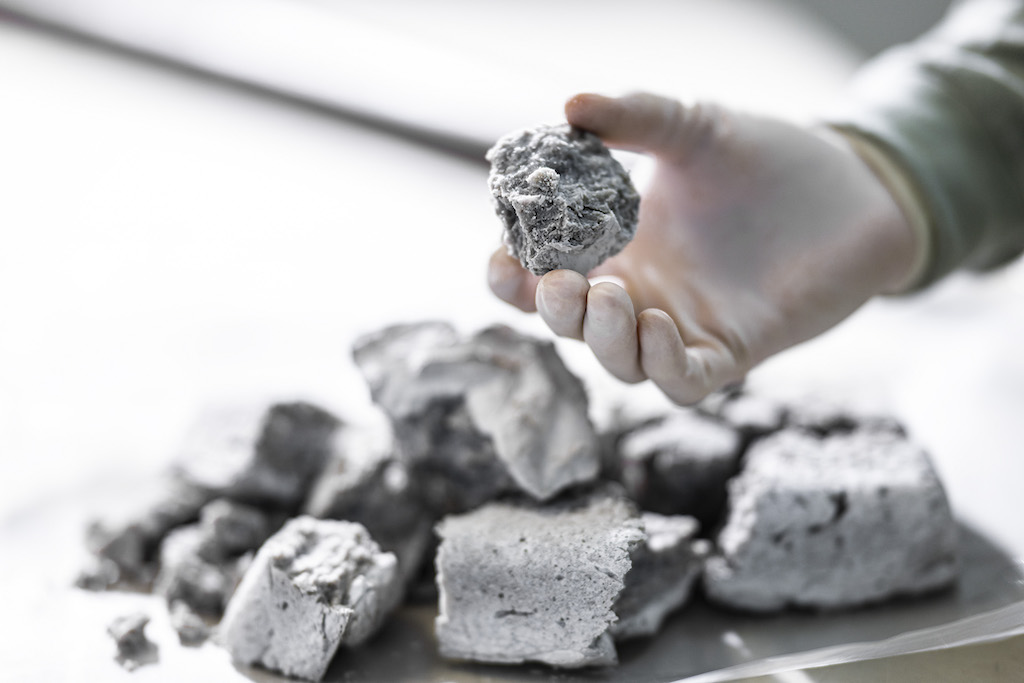
12 Feb Limpopo rare earths project aims to clean up
A rare earths venture at the gateway to the Kruger National Park plans to rehabilitate environmental damage caused by at least six decades of mining. Marcia Moyana investigates
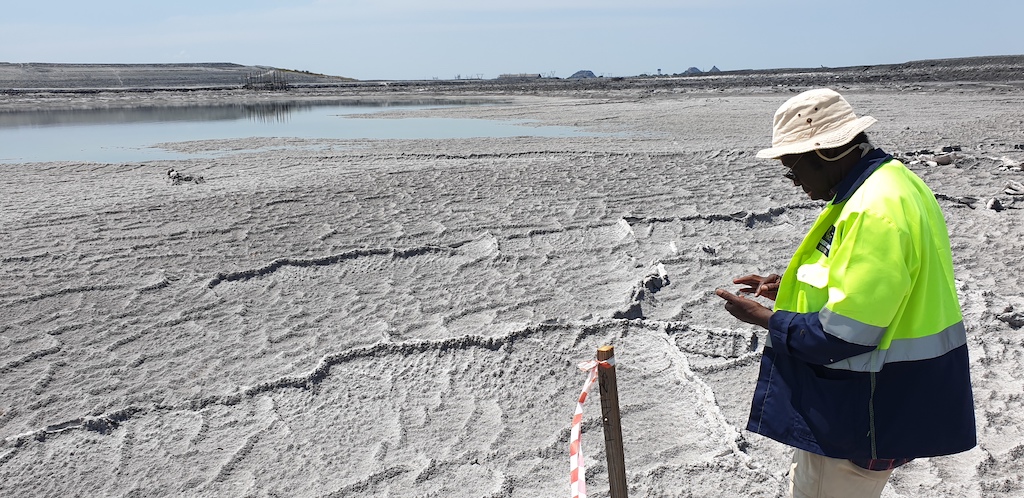
A contractor on site during the resource drilling campaign. Rainbow plans to use the rehabilitation process to revive the economic use of the remaining phosphogypsum. Photo supplied
An ambitious decarbonisation project in Phalaborwa aims to extract valuable rare earth metals while simultaneously rehabilitating an environment damaged by decades of phosphoric acid production.
Located five minutes from the Phalaborwa central business district near the border of the Kruger National Park, the project will extract rare earth metals used in the manufacture of electric vehicles and wind turbines from piles of phosphogypsum – a by-product of phosphoric acid.
According to the company, Rainbow Rare Earths, these metals will play a crucial role in the green economy. Rainbow aims to make up to 98% of the total global rare earth market by 2030, positioning it as a major player in the rare earths-driven decarbonisation project.
“Delivering on our plans will make South Africa one of the first producers of separated rare earth oxides outside of Asia, giving the country a strategic role in the development of an independent and diversified supply chain for critical rare earths,” said chief executive officer George Bennett. “Phalaborwa remains the highest-margin rare earth project in development today outside of China.”
The projected net value of the Phalaborwa project stood at US$611-million as of December 2024, with the London Stock Exchange-listed company noting that the project has lower operating costs and higher margins than similar projects outside of China.
Rainbow spent about $15.7-million between 2020 and 2022 on acquiring an 85% interest in the project and delivering a preliminary economic assessment. A definitive feasibility study from 2024 to 2025 cost about $4.8-million.
Rainbow is projecting that the construction phase will cost about $326.1 million between 2026 and 2027, and that production will start in the last quarter of 2027.
Environmental rehabilitation
According to Bennett, the project’s commitment to rehabilitation and mitigating the ecological damage caused by previous mining operations is a key priority.
The rehabilitation process is expected to create up to 300 jobs, benefiting qualified local residents throughout the projected 16-year lifespan of the extraction process and beyond, according to the company’s preliminary economic assessment, with the land being used optimally for up to 40 years.
The environmental damage at the site can be traced back to 1964, when it was owned by Federale Volksbelegging, a company that produced phosphate-based fertiliser. Sasol took over operations between 2001 and 2012, followed by Bosveld Phosphates until 2014. In 2020, a deal was signed between Rainbow and Bosveld Phosphate to extract the rare earth metals.
The extent of the environmental damage caused by at least six decades of mining is significant. Bennett said that due to the lack of regulations governing mining activities at the time, the stacks of phosphogypsum were not lined, leading to groundwater contamination.

According to CEO George Bennett, the project’s commitment to rehabilitation and mitigating the ecological damage caused by previous mining operations is a key priority. Photo supplied
International principles
“Rainbow will be reprocessing the gypsum stacks, extracting the rare earths and then re-stacking the clean gypsum by-product on to new stacks that have been designed and lined in accordance with the Equator Principles and International Financial Corporation guidelines,” he said.
The principles are applied by financial institutions to identify, assess and manage the environmental and social risks of a project, and the guidelines are used by the World Bank Group to assist clients like Rainbow to protect the environment and achieve their developmental impact goals.
“We will also neutralise the acidic water that has accumulated on top of the existing stacks and use this to meet the water requirements of our processing plant, thereby negating the need to draw on an external water source,” Bennett explained. “The clean gypsum by-product will be sold to local agricultural and other industries over time, meaning that the stacks will eventually be depleted, allowing the land to be fully rehabilitated.”
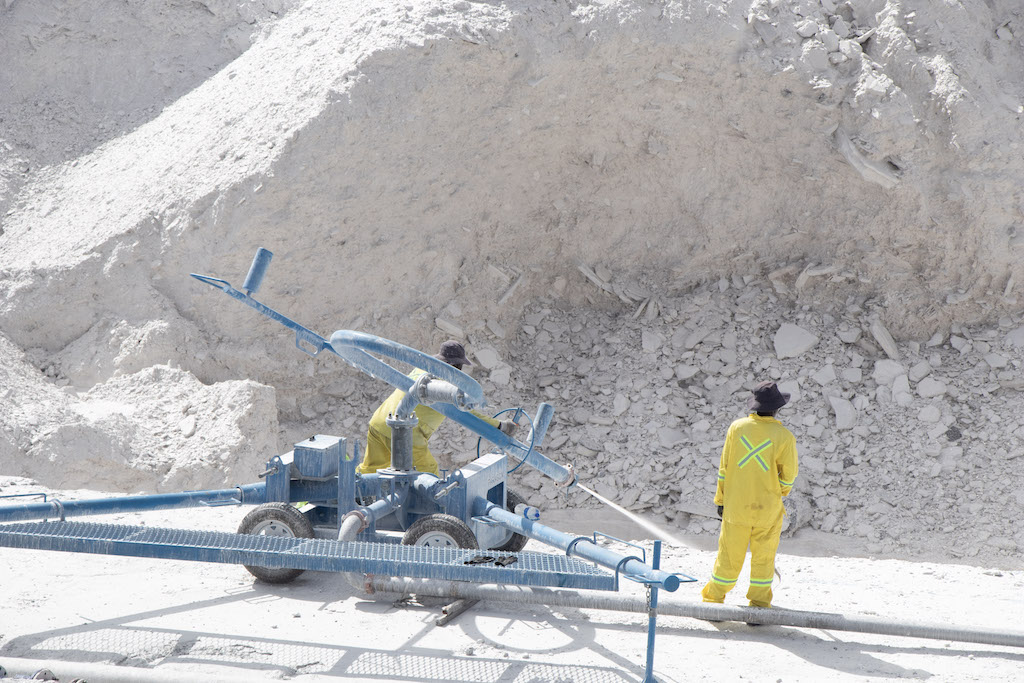
Contractors from Paragon Tailings doing trial hydraulic reclamation of the phosphogypsum stacks. Photo supplied
Is rehabilitation possible?
Mining activities often negatively impact the environment and surrounding communities, causing deforestation, soil erosion, contaminated water bodies (rivers, dams, lakes, and groundwater), increased noise levels and dust.
A two-year investigation by Oxpeckers from 2015 to 2017 showed that very few companies close large-scale mines, and that the money they are legally obliged to set aside for environmental rehabilitation is often minimal.
For a water-scarce country like South Africa, failing to rehabilitate mines that have reached their end of life leaves people, animals and plants vulnerable to consuming contaminated water from acid mine drainage.
The Phalaborwa project, which operates on an existing industrial site without requiring additional excavation, aims to ensure that rehabilitation occurs alongside extraction.
Alseno Mosai, a lecturer and researcher in the Department of Chemistry at the University of Pretoria, said such rehabilitation is possible and has been successfully undertaken by other mining companies in South Africa.
“Previously mined areas can be rehabilitated and returned close to the quality that they had before the mining, or to a safe and a stable condition,” Mosai said.
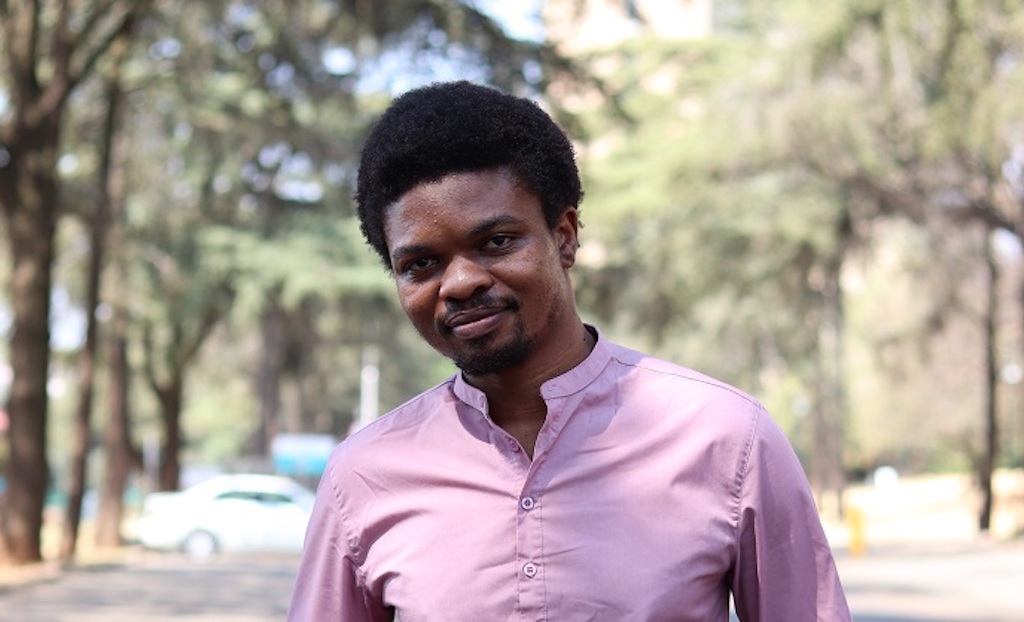
Lecturer and researcher in the Department of Chemistry at the University of Pretoria, Alseno Mosai, says mining companies should consider rehabilitation during the mining process to minimise environmental harm. Photo supplied
Economic use
“Mintek, South Africa’s national mineral research organisation, in partnership with the Department of Mineral Resources and Energy has rehabilitated more than 40 abandoned and derelict asbestos mine shafts in the Northern Cape and Limpopo provinces. As a result, Mintek has rehabilitated over 500ha of asbestos mines,” he said.
Mosai added that this rehabilitation sometimes includes using a previous mining area for activities such as conservation.
Rainbow plans to use the rehabilitation process in Phalaborwa to revive the economic use of the remaining phosphogypsum on site by selling it to the agricultural sector and other industries. The company predicts an average of 2.2-million tonnes of phosphogypsum will be processed a year.
“We will look to employ local skilled labour where possible. We believe there to be good availability of technical skills locally given that Phalaborwa is a long-term mining district with a number of historic and current operations in the area,” said Bennett.
Bennett could not disclose how much money had been set aside for the rehabilitation project.
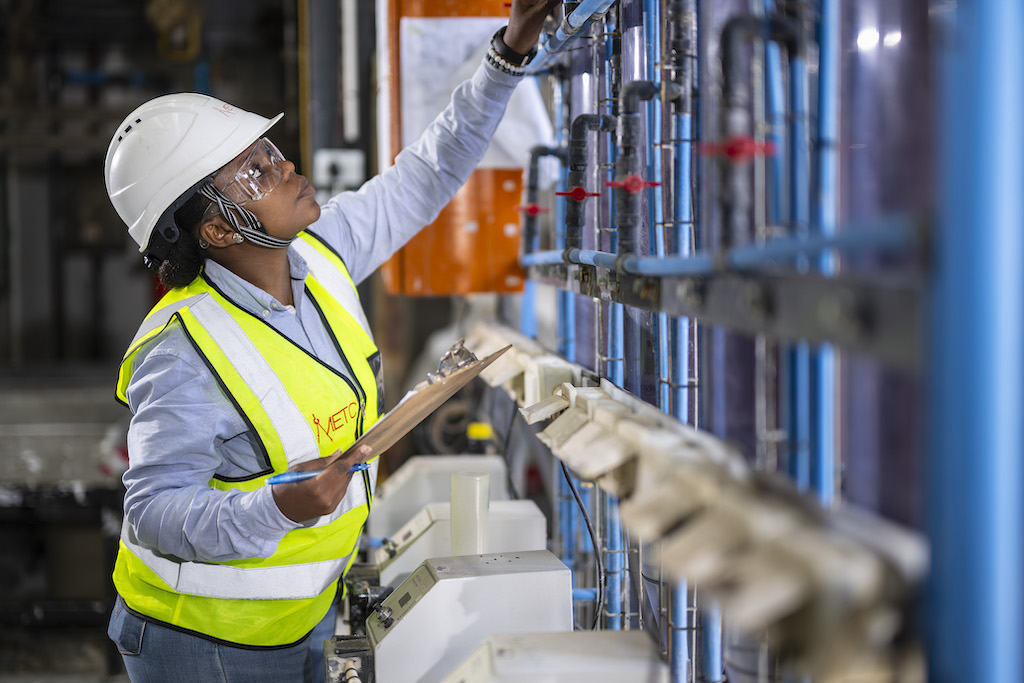
Mamasia Moshokwa from METC Engineering takes test samples at a pilot plant set up at Mintek in Johannesburg to determine what processes are needed to extract the rare earth metals from the gypsum stacks in Phalaborwa. Photo supplied
Critical minerals strategy
Mintek is leading the formulation of a critical minerals strategy for South Africa that will apply to the extraction of the type of metals and oxides Rainbow aims to extract: neodymium, praseodymium, dysprosium and terbium.
“The department is consulting with various stakeholders on the strategy, and thereafter the strategy will be presented to Cabinet for approval,” said DMRE spokesperson Makhosonke Buthelezi.
Asked whether there are other projects in South Africa similar to Phalaborwa rare earths one, Buthlelezi responded: “We would not be aware of extraction projects of a similar nature since they do not involve mining minerals from the ground. In such cases, they would not require a mining right or permit.”
During his keynote address at the annual Mining Indaba on February 3 in Cape Town, Minister of Mineral and Petroleum Resources Gwede Mantashe said a national critical minerals strategy needs to take into account five primary criteria: export significance, local economic impact, industrial importance, employment and global market demand.
“This is informed by our firm view that critical minerals should not be limited to the energy transition. Instead, they must facilitate developmental and sustainability objectives within domestic and international industrial sectors,” he said.
According to Mantashe, the strategy will be presented to Parliament at the end of February.

Charlize Tomaselli, senior researcher at the Alternative Information and Development Centre: ‘Under the current extractivist model, the likelihood of rare earth minerals directly benefiting the majority of South Africans remains slim.’ Photo supplied
Community benefits
While the project offers job opportunities for Phalaborwa residents, concerns persist regarding the equitable distribution of these benefits.
“Without substantial reforms and a shift toward a more just and sustainable economic framework, mining will continue to serve the interests of corporations and global markets rather than the needs of local communities,” commented Charlize Tomaselli, senior researcher at the Alternative Information and Development Centre.
“Under the current extractivist model, the likelihood of rare earth minerals directly benefiting the majority of South Africans remains slim.”

Lebogang Ramafoko, the executive director of Oxfam South Africa, emphasised the need for meaningful community ownership in projects like Rainbow Rare Earths. Photo supplied
Meaningful ownership
Lebogang Ramafoko, the executive director of Oxfam South Africa, said local communities are often excluded from negotiations, leaving them vulnerable to exploitation by mining companies. She emphasised the need for meaningful community ownership in projects like the Phalaborwa rare earths venture.
“We need a radical approach that creates sustainability and meaningful change. This must include women and youths at the negotiating table because our recent research shows that the energy crisis is a gendered one and the just transition cannot happen without us applying a feminist lens to the crisis,” said Ramafoko.
Tomaselli added that a robust critical minerals strategy must enshrine the right to say no, as well as guarantee free, prior and informed consent for mining-affected communities. Currently the Minerals Petroleum Resources Development Act only recognises communities’ rights to consultation and does not enshrine consent.
“This lower requirement leads to disempowerment and exploitation,” Tomaselli added.
Marcia Moyana is a freelance journalist and is studying for an MA in Journalism at Stellenbosch University. This investigation is part of the Oxpeckers #PowerTracker investigative series titled ‘The human cost of energy in Africa’.
• Find the #PowerTracker digital tool and more investigations here
